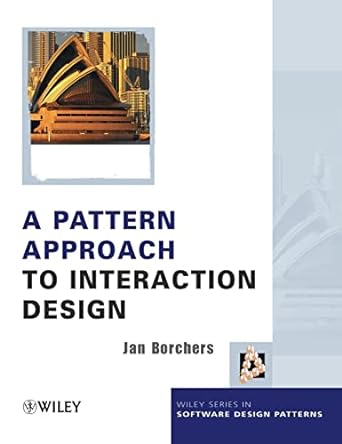A Pattern Approach to Interaction Design
By Jan Borchers
Summary

| Content | 4/10 |
| Readability | 6/10 |
| Presentation | 7/10 |
| Ideas | 5/10 |
| Value for money | 2/10 |
| Did it do what it said on the box? | 3/10 |
How do the rankings work?
The Review
A disappointing book but with some good ideas
This is a deeply disappointing book, typical of a field in which approbation by academic peers seems to be much more important than delivering real help to those designing real user interfaces.
I had hoped for a book dominated by a collection of patterns describing how users interact with technology, particularly computers. Instead the first 3/8 of the book is given over to an almost blow by blow account of each contribution to the development of patterns, their application to IT and finally to HCI. There is actually one important message, that patterns can aid communication not only between IT professionals, but also between professionals and users, as a way of describing both the problem domain and the proposed solution. However, this was almost buried in a detailed discussion of pattern format, which is much less
important.
I very nearly gave up reading at this point, which would have been a pity, since the central chapter of the book contains some interesting patterns, albeit of limited practical use. The "How to Play the Blues" pattern language is an entertaining demonstration of how to use patterns to describe a problem
domain, while the patterns for interactive exhibits are a good set of HCI patterns, although focusing on the interaction of regular users with business computer software would be of more general practical use. I also really liked the pattern layout, relying on typography and styles rather than headings to standardise the structure, which definitely enhanced readability.
Unfortunately the book does not sustain the interest, and after a single chapter on patterns returns to a strange and lengthy self-review, to the extent of reprinting the review comments the author received on a draft version. This is ridiculous.
The book’s malaise seems to be symptomatic of the whole discipline. The referenced web sites and books are not much better, with all but a few noble exceptions concentrating on academic discussions about patterns, rather than building a real pattern collection.
I am convinced that patterns can be really useful in the area of human-computer interaction and user interface design, just as they have been in many other areas of IT. I also think the arguments about style and format will be won by the author of the first good book that concentrates on building a comprehensive and readable set of useful real-world HCI patterns. This isn’t it.
Buy It From Amazon
Amazon.co.uk  |  | Amazon.com
|

 Thoughts on the World (Main Feed)
Thoughts on the World (Main Feed) Main feed (direct XML)
Main feed (direct XML)